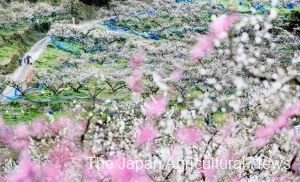WAKAYAMA, April 3 — Agriculture journalist Ayumi Kotani visits sites in Japan designated as Globally Important Agricultural Heritage Systems (GIAHS) to gain insights into revitalizing agriculture and farming villages for a sustainable future.
Visitors to the Minabe and Tanabe districts in Wakayama Prefecture in early spring are impressed by ume Japanese apricot trees in full bloom turning mountain slopes here and there all white.
In particular, Nanbu ume groves in the town of Minabe offer a superb view overlooking the ocean, with some 30,000 people visiting the area during the ume blossom season.
“Visitors are surprised by how steep the slopes are and ask us how the harvesting is done, which makes us feel the struggles of our ancestors are rewarded,” says Yasuhiro Tanaka, head of a group of local ume farmers promoting the district as an ume blossom viewing spot.
https://www.youtube.com/watch?v=RfQGOnnoDR4
Visitors enjoy watching the ume blossoms and tasting umeboshi pickled ume while reflecting on the history of ume production.
The districts, designated as GIAHS in 2015, used to be an impoverished community in the past, as the mountainous area with steep slopes and gravelly soil was unfit for cultivation.
During the Edo period (1603-1868), the area was reclaimed to plant ume trees while also keeping on slopes broadleaf trees such as ubame oak used to make charcoal.
Then the technology for primary processing was established and the main Nanko ume variety was developed and spread as a brand, helping the districts grow into a major production area for high-quality umeboshi.
Currently, roughly 60 percent of the districts’ working population are engaging in the ume producing industry. With an annual production of some 35,000 tons, occupying more than a half of Japan’s total output, the area has developed into the country’s top ume growing region.
Honeybees, indispensable pollinators of ume, are nurtured in fuelwood forests, where the technology of selective cutting is handed down.
They adopt the type of logging in which new branches growing out of tree stumps are left uncut.
This method encourages growth of next-generation trees, enables sustainable logging of trees and also prevents slopes from collapsing as tree stumps are kept.
“Forestry is the starting point of charcoal making,” says Masaaki Hara, 52, who produces Kishu Binchotan charcoal.
Production of high-quality charcoal is not possible without keeping in mind the ecosystem of the mountains as a whole.
In the past, charcoal kilns were set up at various locations in the mountains and charcoal burners used to move from one kiln to another instead of transporting cut wood.
“Charcoal burning traditions have been kept alive thanks to the mountains and the flourishing ume production,” Hara said, describing the ties between farming and forestry activities that make use of so-called satoyama, a place where people and nature exist in harmony.
Fresh attempts are being made to connect growing areas and consumers.
Toshikazu Iwamoto, president of Iwamoto Shokuhin, a 120-year-old company engaging in production and sales of umeboshi, pins hope on the ume cultivation workcation project that started last year as a measure to revive the area.
The project brought some 130 people from metropolitan areas to the districts to stay and experience farming.
Exchanges with the people “created chemistry, bringing motivation and vitality to local farmers,” says Iwamoto, who is busy preparing to accept people again this year.
Love and enthusiasm for the area is what all the people interviewed had in common, leading to a sense of mission and pride for their jobs.
Shota Kitagawa, 32, of Tanabe who used to work for a post office is in his fifth year as an ume farmer.
Kitagawa, who followed the footsteps of an energetic farmer he admires, said, “I want to be a piece of tradition to hand down to future generations the ume production technology which has been built up by ancestors and has continued for 400 years.”
His remarks suggest why the system was designated as GIAHS.
Under the Minabe-Tanabe ume system, high-quality ume is produced on slopes with gravelly soil.
Instead of only growing ume trees, broadleaf forest is partly left to produce Kishu Binchotan charcoal. The fuelwood forest also functions to protect watersheds and prevent collapse of slopes.
The ecosystem is maintained with Japanese honey bees inhabiting in the forest pollinating ume trees.
People in downstream areas have nurtured the ume processing industry and have been engaged in rice paddy farming and growing crops.
It is an agricultural system which makes use of nature and which enabled satoyama where humans and other living creatures coexist to be maintained for 400 years.


